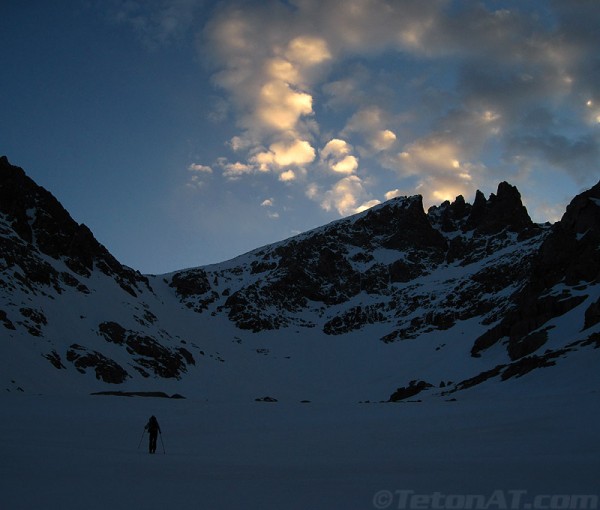
Brian Ladd skins towards Bonney Pass and Split-Tongued Peak in the Wind River Range.
Click all photos for larger images.
After skiing the South Couloir on Fremont Peak and returning to camp, we anticipated the arrival of our good friend Reed Finlay, who was coming to join us to attempt to ski Gannett Peak, the highest peak in Wyoming, the following day. Originally, when I was planning this trip, my thought was to ski a different peak on our second day in Titcomb Basin, push a camp closer to Gannett after that and then 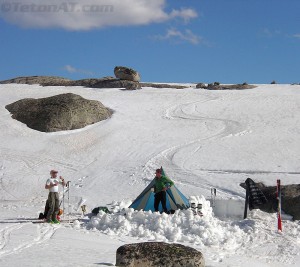 attempt Gannett on our third day. However, Reed was there to try Gannett with us, so plans changed and we decided to give Gannett a try from where our camp was now. Our current camp was only three miles further from the peak than our camp would have been, but after you’ve spent so much energy getting to where you are already, that three miles could be the difference between success and failure, and I was a little uneasy about how things would go.
attempt Gannett on our third day. However, Reed was there to try Gannett with us, so plans changed and we decided to give Gannett a try from where our camp was now. Our current camp was only three miles further from the peak than our camp would have been, but after you’ve spent so much energy getting to where you are already, that three miles could be the difference between success and failure, and I was a little uneasy about how things would go.
Anyway, Reed showed up at about 6pm, making it into Titcomb in only 8 hours, compared to our 10 hour jaunt breaking and packing down the trail. We celebrated his arrival with hot-drinks and nips from the bottle, and discussed our plans for the following day. Everyone was still fired up for Gannett, so we set our watch alarms for 3am, after dinner consisting of ramen and Tasty Bites.
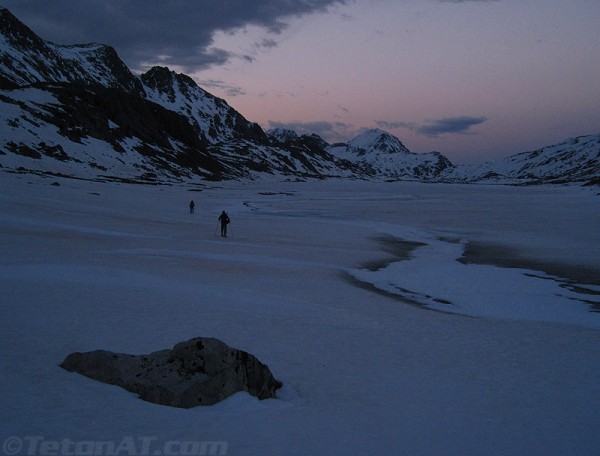
Sleep-skinning in Titcomb Basin.
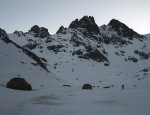 Sleep ended way too early, but I rolled out of the sleeping bag like a soldier, fired up the stove and did my morning ritual that doesn’t seem to need coffee to get moving. We launched from camp with an up-beat tone at about 4:15 and started the march along the shores of Titcomb Lakes as the sky began to lighten. We spread out quickly, which usually isn’t a good sign, but we regrouped at the head of the basin and continued to make our way up to Bonney Pass.
Sleep ended way too early, but I rolled out of the sleeping bag like a soldier, fired up the stove and did my morning ritual that doesn’t seem to need coffee to get moving. We launched from camp with an up-beat tone at about 4:15 and started the march along the shores of Titcomb Lakes as the sky began to lighten. We spread out quickly, which usually isn’t a good sign, but we regrouped at the head of the basin and continued to make our way up to Bonney Pass.
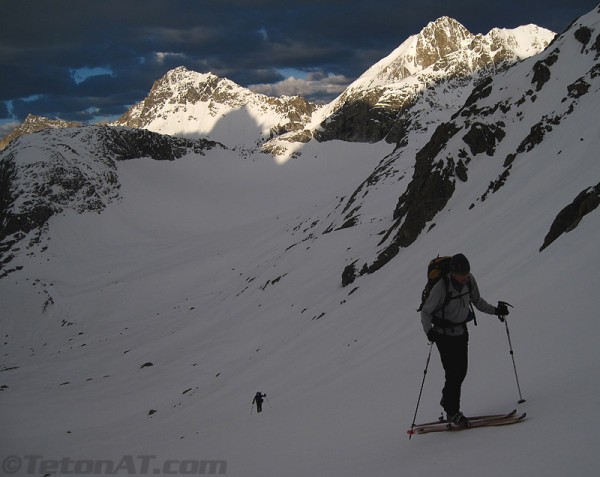
Cool morning light on Titcomb Peaks. Do you know the names of them?
On the way up to Bonney Pass, my legs and energy level deteriorated quickly and I resorted to rest-stepping for the entire 1,500′ climb. Clouds began to fill the sky, adding an ominous feel to the day and soon I found myself at the pass and staring at an amazing view of Gannett reflecting the early morning sun.
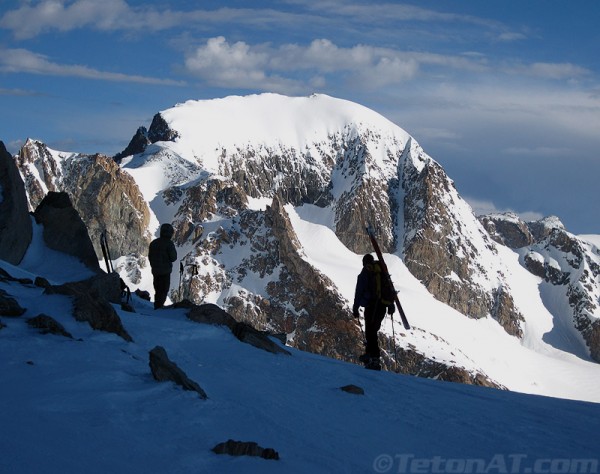
The majestic Gannett Peak from Bonney Pass.
Having skied with Reed about a gazillion times, I knew right away by the look in his eye that he was feeling the effort of the previous day. Brian was a little more motivated, maybe since he hadn’t skied Gannett before (Reed and I have), but not enough to really push things and the weather, especially for only being 7:30am, was actually relatively threatening. The decision was easy and there was no way our mind and bodies were going to be able to focus on the planned objective. After about an hour of lingering at the pass, we pulled the plug and skied on rock-solid snow to the base of Bob’s Towers to re-asses.
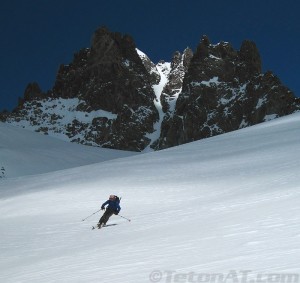 At this point, I was pretty indifferent about the rest of the day, internally thinking about what to focus my sights on the following day, but Brian stayed focused and lured us up to a high point above Sphinx Glacier, which sits below Woodrow Wilson and The Sphinx. This was our first time into this zone, but I’ve admired the couloir that splits Woodrow Wilson’s summit massif and the cool wind ridge feature that forms on the glacier below. I knew my legs weren’t up for the 50+ degree couloir today, but at least skiing the wind-fin would be fun.
At this point, I was pretty indifferent about the rest of the day, internally thinking about what to focus my sights on the following day, but Brian stayed focused and lured us up to a high point above Sphinx Glacier, which sits below Woodrow Wilson and The Sphinx. This was our first time into this zone, but I’ve admired the couloir that splits Woodrow Wilson’s summit massif and the cool wind ridge feature that forms on the glacier below. I knew my legs weren’t up for the 50+ degree couloir today, but at least skiing the wind-fin would be fun.
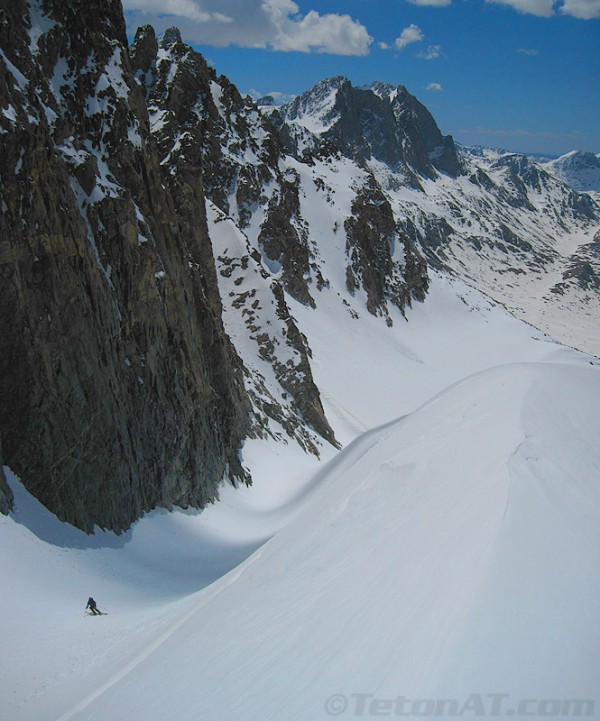
Reed skis in the womb next to Sphinx Glacier.
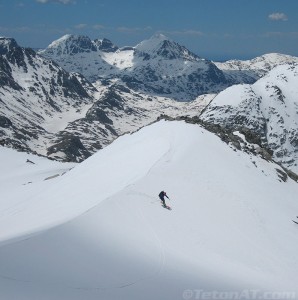 After a lunch break battling the wind on a ridge above 13k’, we clicked in and began our descent. Traversing to the skiers left, I arrived at the wind-fin, which was much more impressive up close. Its skier’s left side dropped steeply into cool gully and I watched as Reeders dropped in and make turns in the gut. It looked really cool, but I stayed high on the glacier and soaked up the views that I would say rivals any mountain vista in the world. The Wind River Range is truly a wild place and I like the fact that it is difficult to get back here to ski, which enhances the remote feeling you get when you are there.
After a lunch break battling the wind on a ridge above 13k’, we clicked in and began our descent. Traversing to the skiers left, I arrived at the wind-fin, which was much more impressive up close. Its skier’s left side dropped steeply into cool gully and I watched as Reeders dropped in and make turns in the gut. It looked really cool, but I stayed high on the glacier and soaked up the views that I would say rivals any mountain vista in the world. The Wind River Range is truly a wild place and I like the fact that it is difficult to get back here to ski, which enhances the remote feeling you get when you are there.
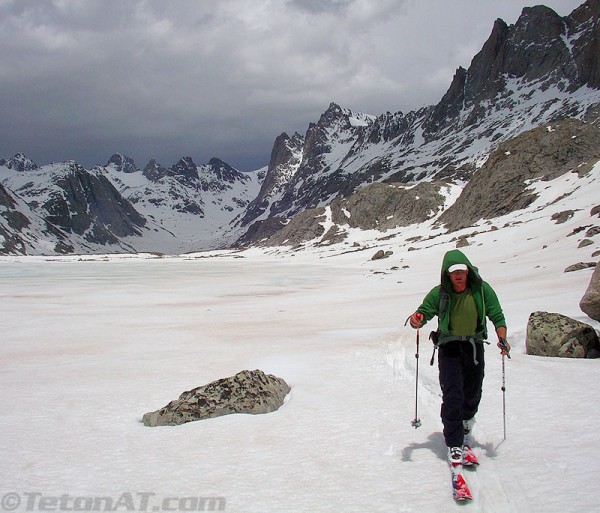
Randosteve skis back to camp as storm clouds build.
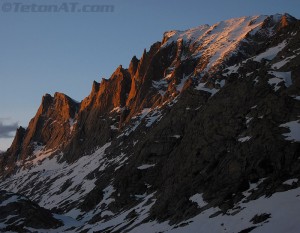 Back in the basin, the temps began to soar as the sun’s rays reflected off the mass amounts of granite which tower up to the high peaks in the basin. The wind bringing in weather from the south also made staying hydrated nearly impossible and my head felt like a raisin by the time we reached camp. We all cashed out for a little while and on occasion, graupel pattered the mega-mid as we rested and recovered for the next day skiing in Titcomb Basin. To be continued…
Back in the basin, the temps began to soar as the sun’s rays reflected off the mass amounts of granite which tower up to the high peaks in the basin. The wind bringing in weather from the south also made staying hydrated nearly impossible and my head felt like a raisin by the time we reached camp. We all cashed out for a little while and on occasion, graupel pattered the mega-mid as we rested and recovered for the next day skiing in Titcomb Basin. To be continued…


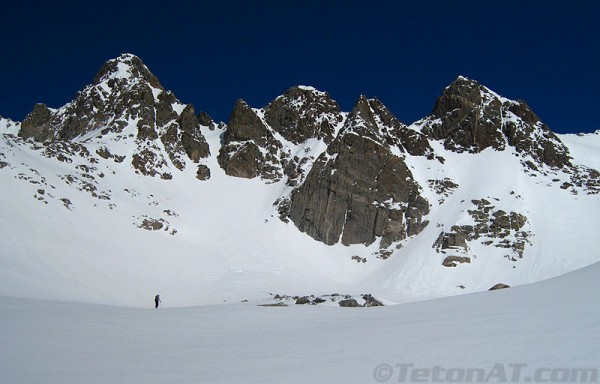
Another great write up with stunning pics! Does it really storm (lightning) up there?
Man, I tell you – digging these TRs from the Winds. I wasn’t really familiar with this range at all before this, but I am really impressed. Gorgeous mountains and lines. Good stuff!
SO COOL, Like I have said before the winds are the best place to get away in the lower 48. It will remain like this for a long time because it is truly a place that requires tons of work to get a reward. Every morning I woke up to go to work I would look up at Gannett knowing that you guys were probably booting/skinning up it as the sun was coming up. The weather window was pretty nice from what I could tell. Steve what made you choose Sky Line and Elk Heart Park, vs GR lakes where you did the trail run from, or the Reservations side where you came from to ski Gannett last time? Distance, snow cover elevation change etc?
adayak…yes…there are thunder and lightning storms in the wind rive range. we only had some graupel on this trip.
derek…i really wanted to ski that south couloir line on fremont…so elkhart was the obvious approach. i thought i’d be able to motivate for gannett…but no such luck. coming in from the res costs $200 a person, so it’s a bit pricey to go backcountry skiing if you use that trailhead. if i was just going for gannett, i would definitely use dubois as the start instead of the other options.
What was the distance from camp to car?
derek…i’d call it 12-14 miles from elkhart trailhead to lake 10,548 where our camp was. my topo program read 11.something miles…but i figure it is a bit longer since it is hard to account for switchbacks and such when you are tracing a line on the trail.
my guess is if one were to head into titcomb basin now…they would be walking on the trail until just before island lake on the way in.
Ya I can see the snow melt since you guy go out. lol
Steve – how does this years snowpack in the Winds compare to average? How long do the Winds typically hold snow (well, enough for most lines to go with skinable approaches). I realize the later question is totally in the eye of the viewer as far as “skinable approaches” – but I will leave it up to you to make that call.
Basically, how does it compare to a spring Sierra snowpack as far as average season?
nick…this year’s snow pack is a bit above average…but mainly only at high elevations. last year i skied in the winds on the 4th of july and it was good…but with a long approach on foot…not skis. two years ago i skied gannett on june 1st and we had dry sections of trail near dinwoody creek. other years i had done trips in april in the northern range and have walked for miles before putting my skis on.
the winds are much different than the sierra and get much less snow…and obviously…skiers as well. out of dubois, you will always walk at the start of the approach no matter what time of year it is. it is that dry. yet at the same time, other trailheads are inaccessible by vehicle until may.
timing is everything in the winds, in that first you wait for the roads to dry out so you can get to the trailhead, then you try to get it so you can skin car-to-car…then you wait until it is dry so you can get far in there so you have less transitions.
the wind river snowpack and logistics are so different from the sierra that i find it hard to answer your question.
Thanks Steve. You actually answered it by showing essentially that it is completely different than the Sierra (my base case comparison). Varying snowpack, difficult logistics, remote…. etc.. Sounds awesome.
[…] on the move again, we ate up vertical quickly as we were both feeling strong again after yesterday’s sluggishness, and we stopped once below the crux in order the pull out the ice axes, since things looked to get […]
Steve, If you get a chance sometime, could you summarize you gear and food strategy for summer ski camping? Thanks. Jim
jim…here’s some beta…i usually bring to much stuff.
tent/bivy…though most times i roll with a mega-mid, i would use a bivy if my trips were shorter, or i am moving camp every night…AND i knew the weather was going to be nice.
sleeping bag/pad. summer weight bag…i have a marmot hydrogen 30 degree. i usually ditch the exped downmat7 once the temps warm up and use a big agnus insulated aircore pad that i have. for shorter trips i’d be willing to bump down to an ultralight pad…like small thermrest prolight pad. i need all the help i can get to sleep.
stoves…ideally i like to use jetboils once the temps warm up and i’m not melting water for snow. the pots double great as a mug and bowl…add a spoon and you’re good to go. works great if your partner also has a jetboil pot.
water…dedicated hydration bladder user. i like the msr hydromadary set up. to save weight, i don”t mind using purification tablets over a water filter…but sometimes the filter does make accessing water a bit easier when you are dealing with snowbanks along creeks and melting lakes. nuun tablets mask any residual flavor from the tablets…and aresuper easy to use.
food…this is usually where i flail…or end up going for comfort and tastiness over weight savings. candy bars, Probars, GUs, Chomps, Nuun, salami, cheese, crackers, gummies, ramen, chicken, tasty bites, hot chocolate, coffee…ALL make it into the food bag. on this trip i ended up carrying out easily what i would call another days worth of food…so my judgment was off when packing. that being said, it’s also nice to have a little food back up…in case you are forced to be out longer than you thought.